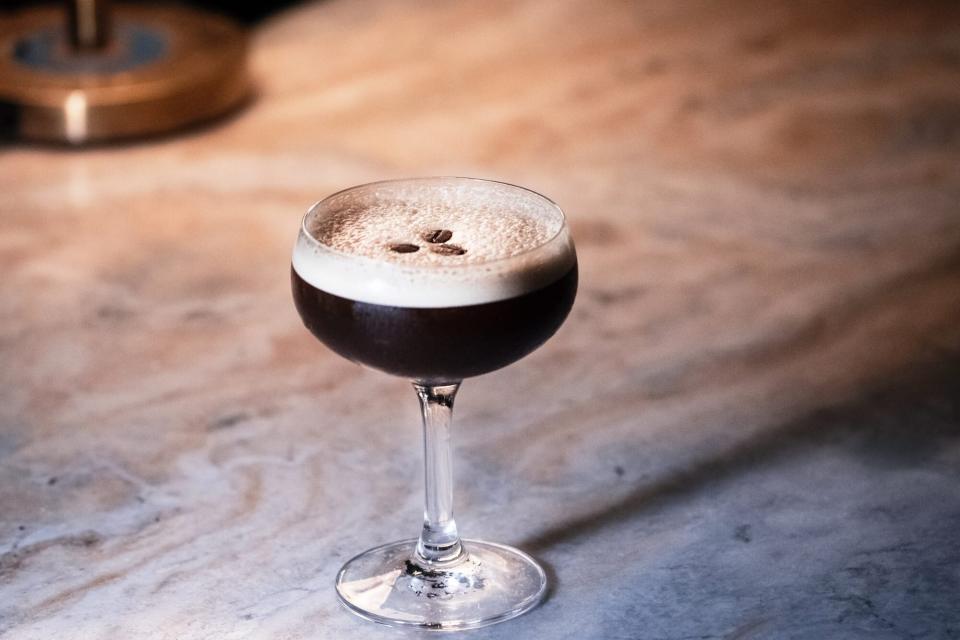The Espresso Martini Is Having a Moment (Again)
If you've been active on social media lately, glanced at any food and drink publications, or perused a few bar menus recently, you've probably seen something about espresso martinis. The coffee-fueled cocktail, which had a brief surge in popularity in the '80s and '90s, is making a comeback this summer. According to lore, the espresso martini was invented in London in 1983 by bartender Dick Bradsell. It became super popular in the U.K., made its way to Australia (where it remains one of the most-ordered cocktails), and finally to the U.S., where it enjoyed its heyday before fizzling out around the millennium, along with the Cosmo (which is also enjoying a resurgence).
The classic version of the cocktail is made with freshly brewed espresso, a coffee liqueur, sugar, and vodka, and it's often garnished with three coffee beans. It's shaken with ice and served in a chilled martini glass. And while in the '90s heyday of the drink, the coffee liqueur of choice was typically Kahlúa, these days you're more likely it find it made with Mr Black Coffee Liquor, an Australian company that uses Arabica coffee and Australian wheat vodka at their roastery and distillery north of Sydney. Founded in 2013, it's now the fastest-growing coffee liqueur in the U.S.

Courtesy of Maple & Ash / Jake Huke
"There's no doubt that Mr Black played a starring role in the resurgence [of the espresso martini]," says Tom Baker, co-founder of Mr Black Coffee Liquor. "In five short years we're now in 5,000 outlets across America and bartenders are proud to put the drink on their menu." In the last year, Mr Black has seen exponential sales growth and in 2020, Mr Black surpassed Tia Maria to take the #1 spot within super-premium coffee spirits. Baker credits these and other bars with elevating the espresso martini from its original too-sweet origins into a classy craft cocktail. "They've rescued the drink from the over-sweetened fake flavors of the '80s, and made it into a contemporary classic. Real coffee, quality spirits, carpe noctem."
Related: How to Make Ice for Cocktails
But what is driving the increase in popularity today? Talk to a few bartenders and many admit they've been getting more orders for the cocktail in the last year. Did the pandemic make us all exhausted and desperate to drink at the same time? Are the Roaring 20s really returning after lockdown, with revelers looking for the perfect caffeine-and-booze-fueled drink? No one can say for sure, but it's undeniable that the espresso martini is gaining ground. "It wasn't until the reopening of bars and restaurants across America after the COVID lockdowns that the drink shot into the collective consciousness," says Baker. "People where looking for something to put a spring in their step and welcome them back to the bar."
Frank Gaffney, bartender at The Monsaraz San Diego, thinks the smell of coffee has something to do with it. "The sense of smell is the strongest and quickest memory inducer," he says. "Coffee is (I assume) closely linked to every pleasant morning you've ever had and after such a crappy year, people are yearning for anything that will bring the, back to a sense of normalcy, if even for 10 minutes." Steve Groom, bar manager at Costera in New Orleans, surmises that the drink's visual appeal also helps. "People see that drink and they're like, "I want one of those!' Chain ordering at its finest."
When head bartender Linda Garcia put out her soft opening menu a few months ago at Fats Duvall's Rhum Café in New York City, customers clamored for her espresso martini, originally intended for the fall, to be included on the menu now. "They consider it a good desserty drink that can be enjoyed alone or with dessert, or as a wake-up call," she says.
Other bartenders say the espresso martini never left, it just got better. "People started to really focus on the quality of the ingredients going into the cocktail. At Highlands in Detroit, we use housemade cold brew, freshly brewed espresso, housemade cinnamon syrup, Eastern Kille Coffee Liqueur (out of Grand Rapids, Michigan), a little crème de cacao, and Reyka vodka," says John Neely, bar manager at Highlands. Additionally, the more readily known ease of making high-quality cold brew (and the fact that many good cold brew concentrates can be purchased) has also allowed bartenders to easily and quickly make a craft espresso martini in lieu of having to pull a fresh espresso every time the cocktail is ordered (if the bar even has an espresso machine), which takes time.
Related: 12 Classic Cocktail Recipes Every Aspiring Mixologist Needs to Know How to Make
How to Make an Espresso Martini
Whatever the reason, the undeniable popularity of the espresso martini means it's a drink you should try—if you haven't already. Make one at a home with this classic recipe from Eric Simmons, the beverage director of Maple & Ash in Chicago. This recipe makes one drink.
Ingredients:
2 oz Grey Goose Vodka
1.5 oz espresso
1 oz Mr Black Cold Brew Coffee Liquor
0.25 oz Demerara Simple Syrup
3 coffee beans, for garnish
Method:
In a cocktail shaker with ice, shake all ingredients except coffee beans.
Strain into a coupe glass.
Garnish with three coffee beans before serving.

